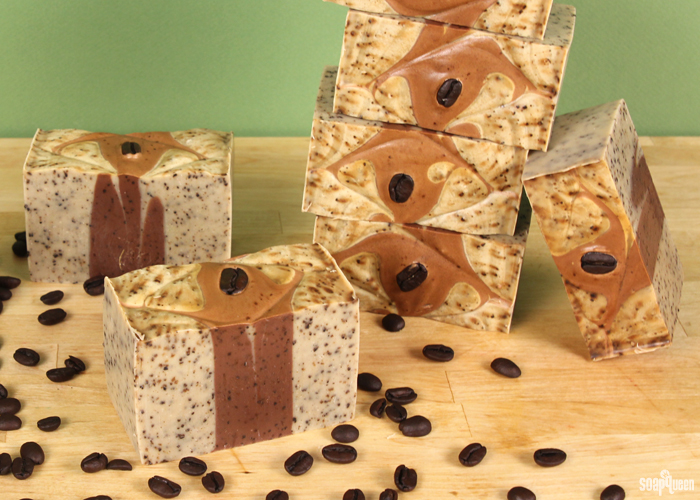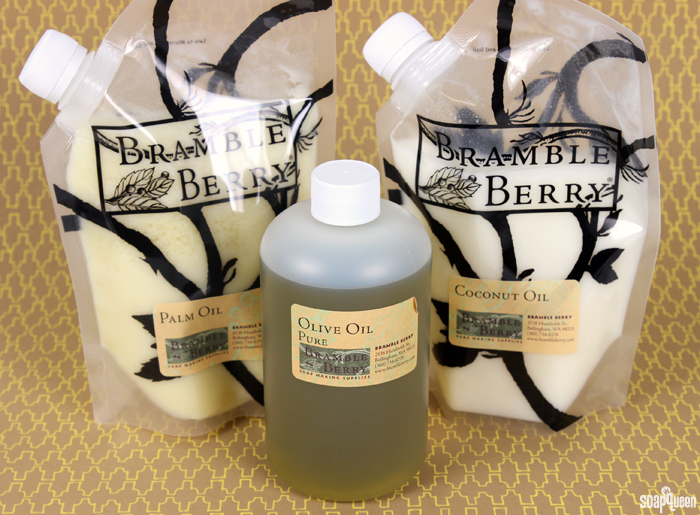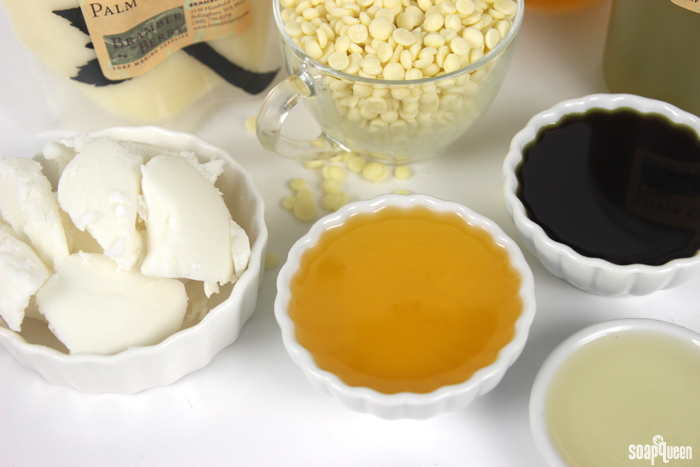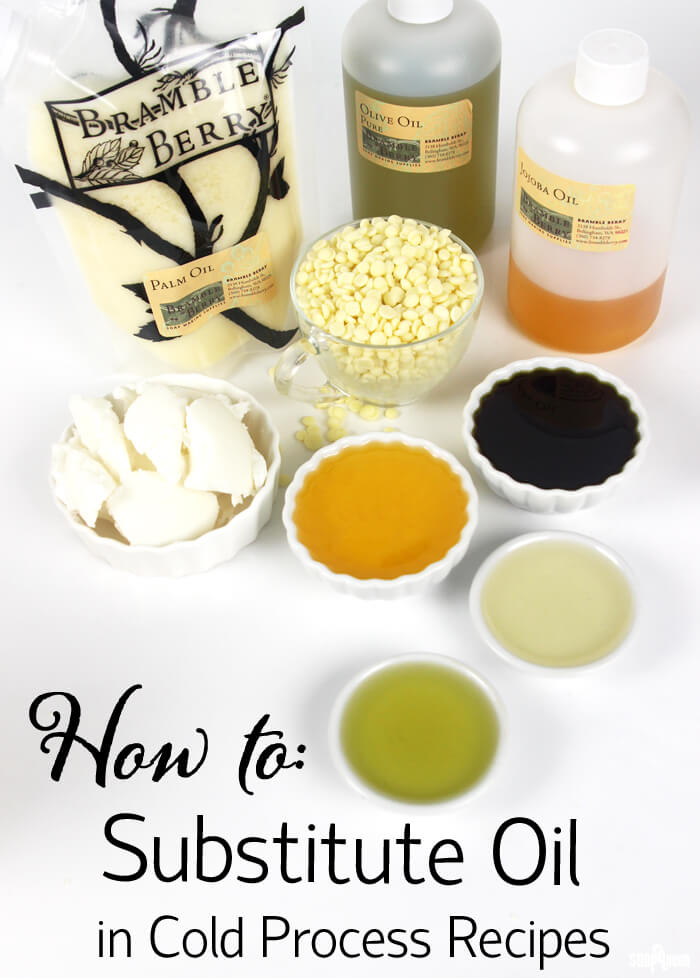 Selecting soap making oils and butters is a fun and personal process. Each oil and butter contributes various properties to the finished bar. For example, some oils may give a silky lather, while others may contribute extra moisturizing properties. Many soapers spend years perfecting their cold process recipes to create what they consider to be “the perfect bar.” The great thing about making your own soap is recipes can be altered depending on personal preference, or with what oils you have on hand. But be careful, not every oil substitution is made equally!
Selecting soap making oils and butters is a fun and personal process. Each oil and butter contributes various properties to the finished bar. For example, some oils may give a silky lather, while others may contribute extra moisturizing properties. Many soapers spend years perfecting their cold process recipes to create what they consider to be “the perfect bar.” The great thing about making your own soap is recipes can be altered depending on personal preference, or with what oils you have on hand. But be careful, not every oil substitution is made equally!
Before jumping into the complicated world of substituting oil in cold process recipes, I recommend reading theFree Beginner’s Guide to Soapmaking: Common Soapmaking Oils blog post. The key to substituting oils is to find an oil with similar properties in terms of how it behaves in soap. The Common Soapmaking Oils blog post provides a brief profile on each oil including what properties it contributes to soap, along with recommended usage rates.
In addition to this handy blog post, I also recommend becoming familiar with the Lye Calculator. The calculator is key for determining how much lye is necessary to turn the oils in your recipe into soap. For more information on how to use the calculator, check out the Using the Lye Calculator blog post. When substituting oils in a recipe, remember: always run the recipe through the Lye Calculator again. Even if you are using the same amount of oil, the amount of lye necessary to turn the oil into soap may be different.
The amount of lye necessary for the recipe depends on the saponification value of each oil. The saponification value (aka: SAP value) refers to the amount of lye it takes to turn 1 gram of oil into 1 gram of soap. The SAP value for each oil and butter may vary slightly depending on where it comes from. Because SAP values can vary, one lye calculator may give slightly different results than another calculator. When substituting oils in recipes, the SAP value can be helpful to identify oils that behave similarly. Keep in mind the SAP value does not reveal the characteristics (such as lather and moisture) that the oil gives to soap.
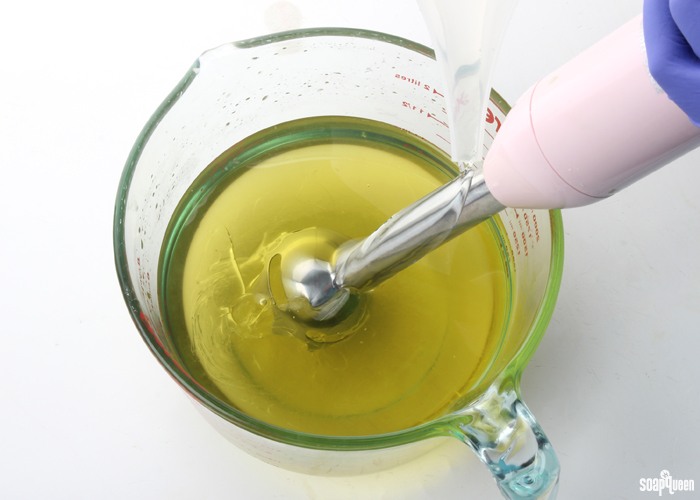 The amount of lye needed for the recipe depends on the type, and amount of oils used. Remember to always run your recipe through the Lye Calculator to ensure proper lye and water amounts.
The amount of lye needed for the recipe depends on the type, and amount of oils used. Remember to always run your recipe through the Lye Calculator to ensure proper lye and water amounts.
Some of the best cold process recipes contain a combination of both hard and soft oils. What is a hard oil, and what is a soft oil? A hard oil or butter is solid at room temperature. Some of the most common hard oils includepalm oil and coconut oil. Butters such as cocoa, shea, avocado, coffee and mango are a mix, but most consider them to be hard oils as well. In order to use these oils in cold process soap, they must be melted to a liquid state. Hard oils and butters contribute firmness to the final bar. If the recipe does not contain enough hard oils, the bar may be soft or sticky to touch.
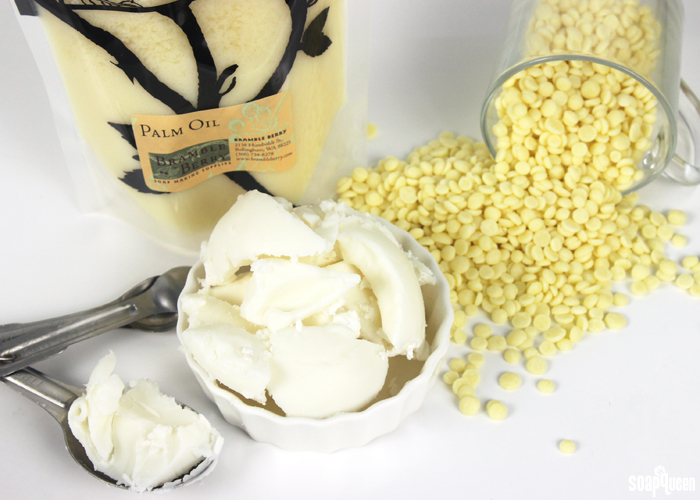 Shown above are palm oil, shea butter and cocoa butter. All three are hard oils because they are solid at room temperature.
Shown above are palm oil, shea butter and cocoa butter. All three are hard oils because they are solid at room temperature.
Soft oils refer to oils that are liquid at room temperature. The list of soft oils is expansive, but some of the most popular include olive oil, canola oil, rice bran oil, avocado oil, and sweet almond oil. Soft oils contribute skin-loving properties to soap, and ensure it is not brittle. Soft oils also help prevent the soap from cracking.
When substituting an oil from a recipe, the first step is to consider what kind of oil it is. Is it hard, or is it soft? In general, hard oils should replace hard oils, and soft oils should replace soft oils. Doing so will help maintain the balance of hard and soft oils. Once you’ve narrowed down the texture of the oil, consider what the oil does for the recipe. Does it give the soap firmness, moisture, or contribute to the lather? Selecting an oil with similar soaping qualities helps retain the properties of the original recipe. Of course these guidelines are not absolute; For example, if you want to soften the original recipe, you may replace a butter with a soft oil.
Remember, there are no concrete rules when it comes to substituting oils in cold process recipes. Let’s take a look at the Espresso Shot Cold Process recipe below, which features cocoa butter. The percentage of each oil and butter are listed as well.
Espresso Shot Cold Process Recipe:
16.5 oz. Olive Oil 30%
13.7 oz. Palm Oil 25%
13.7 oz. Coconut Oil 25%
2.7 oz. Hazelnut Oil 5%
2.7 oz. Coffee Butter 5%
5.5 oz. Cocoa Butter 10%
7.7 oz. Sodium Hydroxide
18.1 oz. distilled water
This recipe contains the normal 20-30% of olive oil, palm oil and coconut oil. It contains 10% of cocoa butter, which is an extremely hard butter. Coffee butter is also a hard oil, but is slightly softer than cocoa butter. Hazelnut oil is light, non-greasy liquid oil that is great for dry skin. You’re ready to recreate this recipe, but realize you don’t have any cocoa butter. What else could you use?
The cocoa butter makes this soap firm. Other oils that give this recipe firmness are the palm oil and coffee butter. One option is to slightly increase the palm oil to 30%, and increase the coffee butter to 10%; increasing these oils will make up for the firmness you lose by omitting the cocoa butter. Another option would be to increase the palm to 30% and the hazelnut oil to 10%. This option will result in a slightly softer bar. Palm kernel flakes would also make a great substitution. However you choose to tweak the recipe, don’t forget to run the new oil amounts through the Lye Calculator! There are many more substitution options for this recipe. The key to substitutions is to consider what qualities the oil gives to the soap, and how it interacts with the other oils in the recipe.
Substituting Palm, Olive & Coconut Oils:
Palm, olive and coconut oil are the three most common soap making oils. Many recipes revolve around these three oils. Palm oil contributes firmness, coconut oil provides cleansing properties and olive oil gives the bar softness and skin-loving attributes. The combination of these three oils creates a bar that is firm, cleansing and moisturizing. A very common soap recipe involves using 30% olive, coconut and palm oils with an additional 10% extra oil. Looking to substitute one of these oils? Here are my recommendations and tips:
- Replacing Palm Oil: Palm oil gives soap firmness and is a secondary lathering agent. It makes soap easier to unmold, and contributes to a thicker trace. When replacing palm in a recipe, you’ll want to find an oil/butter that contains high amounts of palmitic or stearic acid. If you are looking to replace palm oil, tallow is a popular option. Tallow is a rendered form of beef or mutton fat. Tallow gives soap firmness, and a creamy lather. It is not particularly cleansing, and because of this it is often combined with coconut oil. For more information on tallow, click here. Another option when formulating a recipe without palm, is to use other hard oils such as butters or palm kernel flakes. Keep in mind, palm oil can be used up to 30% in cold process recipes, while butters and palm kernel flakes should be used at 15% or below. Adding sodium lactate to your palm free recipe helps the soap harden faster, making soft recipes easier to unmold. Sodium lactate should be used at a rate of 1 tsp. per pound of oils.
- Replacing Coconut Oil: Coconut oil is a unique soap making oil. In addition to adding firmness, it gives the recipe cleansing properties and a full lather. Because of its cleansing nature, using more than 30% coconut oil can result in soap that is drying to the skin. In my opinion, coconut oil is the trickiest oil to substitute. If you are looking to formulate a recipe without coconut oil, palm kernel flakes can help. I recommend using 15% or less of palm kernel flakes in your cold process recipe.
- Replacing Olive Oil: Olive Oil is extremely gentle, and gives soap a mild and creamy lather. Olive oil can be used up to 100% in cold process recipes; soap made with 100% olive oil is referred to as castile soap. Good substitutes for olive oil include rice bran oil and canola oil. Both rice bran and canola oil contribute a creamy lather, very similar to olive oil. Rice bran oil can be used up to 100%. while canola is recommended at 40% or below. Pomace olive oil is very different from pure olive oil. Pomace olive oil is made by extracting the last bits of oil and fat from the paste left over from pressing extra virgin olive oil. Pomace olive oil speeds up trace more so than pure olive oil, and adds hardness.
Below is a list of common soap making oils, along with oils that have similar properties. Keep in mind that while oils may have similar soaping characteristics, they may have different usage rates. For example, if you need to make soap without coconut oil, palm kernel flakes also give cleansing and firmness. But, palm kernel flakes have a slightly lower usage rate than coconut oil. While these oil substitutions will maintain the basic makeup of the recipe, some oils have unique properties that cannot be substituted, like castor oil. And of course, don’t forget to always run your recipe through the Lye Calculator! If you make a substitution, we recommend making a small test batch of soap. That way you can see how the soap feels with the new ingredient and make adjustments if necessary.
Common Soap Making Oil Substitutes
Apricot Kernel Oil: Sweet Almond Oil, Hazelnut Oil
Avocado Oil: Chia Seed Oil, Sweet Almond Oil
Avocado Butter: Shea Butter, Mango Butter
Canola Oil: Olive Oil, Rice Bran Oil
Castor Oil: No substitute
Cocoa Butter: Beeswax, Shea Butter, Palm Kernel Flakes
Coconut Oil: Palm Kernel Flakes, Tallow
Coffee Butter: Avocado Butter, Shea Butter
Chia Seed Oil: Sweet Almond Oil, Avocado Oil
Grapeseed Oil: Olive Oil, Hazelnut Oil
Hazelnut Oil: Grapeseed Oil, Apricot Kernel Oil, Hemp Seed Oil
Hemp Seed Oil: Avocado Oil, Hazelnut Oil
Jojoba Oil: Meadowfoam Oil
Mango Butter: Avocado Butter, Shea Butter
Meadowfoam Oil: Jojoba Oil
Olive Oil: Rice Bran Oil, Canola Oil, Grapeseed Oil
Palm Oil: Tallow, Palm Kernel Flakes
Palm Kernel Flakes: Palm Oil, Coconut Oil
Peanut Oil: Olive Oil, Canola Oil
Rice Bran Oil: Olive Oil, Canola Oil
Safflower Oil: Canola Oil, Sunflower Oil
Shea Butter: Avocado Butter, Mango Butter
Sunflower Oil: Olive Oil, Safflower Oil
Sweet Almond Oil: Apricot Kernel Oil, Avocado Oil, Chia Seed Oil
Tamanu Oil: Neem Oil, Pumpkin Seed Oil
Remember, if you do sub out any oils in your soapmaking, always run it through a lye calculator!

